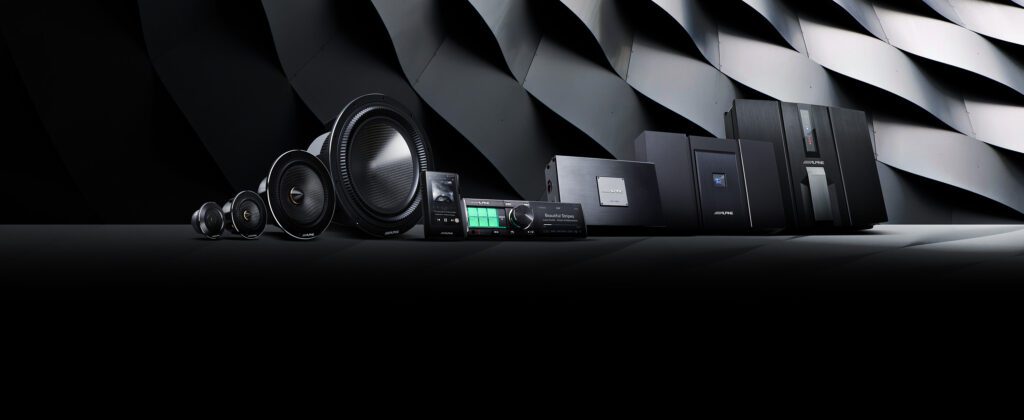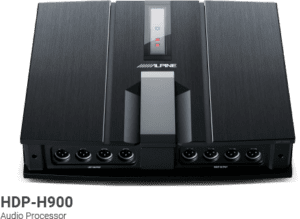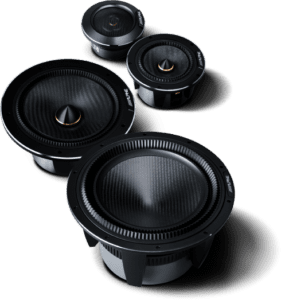Home > News & Opinion > Alpine Status F#1 – The Only All-In-One ($35k) High-Res Car Stereo
In This Article: We will discuss everything that makes the Alpine Status F#1 high-resolution car audio system unique.
High-resolution car audio was little more than a dream only a few years ago. The complexity of producing high-res audio in an automobile was not practical and the basic components necessary did not exist. All that changed in 2001 when Alpine introduced the first-ever Status F#1 high-resolution system. In December 2021, Alpine released the third generation of the F#1 system to finally bring stunningly realistic audio to the automotive industry.
What Is High-Resolution Audio?

Imagine that you are in the recording studio with your favorite band. Through your headphones, you can hear each note and each chord, but you can also hear the tiniest of sounds. Fingers on strings, the hush of the singer's breath, even the most gentle sounds all come through. But, when you play that same track back in your car, a lot of those minuscule parts of the music are lost.
Music is recorded at rates as high as 384kHz/32bit sample size but CDs and music for streaming services can only process at 44.1kHz/16bit sample rates. This difference is information about the music that is lost in the compressed format.
When music is stored in most formats, it is compressed. The compression causes the unique sounds to be lost so that just the key parts of the music are kept. The audio files usually sound good enough, but a true audiophile will immediately hear the difference.
Many high-end home theater systems have the capacity to produce high-resolution audio. These systems tend to be large and expensive but offer the highest sound quality possible.
Car Audio Limitations to High-Resolution Audio
There are a number of reasons that high-resolution audio has been impractical in the automotive industry. For starters, most vehicles are too loud to appreciate the nuances of high-res music. Factors such as wind noise, tire noise, and engine noise cancel out some of the sounds you would otherwise hear with clarity.
Speaker positions in cars are not conducive to creating an ideal listening environment since the same sounds hit your ears at different times. And then there are the problems of actually reproducing high-res audio. Reproduction requires a high level of digital signal production and a very fast clock speed to manage the various frequencies. Then, each component of the system needs to be of the very highest quality to take advantage of the available high-res audio signal.
Today’s vehicles are much quieter than cars built even just a decade ago. This is even more true with the latest electric vehicles that make practically no sound at all. Advances in sound insulation have also created car interiors that are significantly quieter than vehicles of the past.
In general, car audio technology has also improved. Many car amplifiers now feature built-in DSPs and the latest head units have advanced circuitry that enables playback of higher-quality audio files. The combination has created the perfect environment to take advantage of all that the Alpine Status F#1 system offers.
Alpine Status F#1 Review

Most of the car audio systems out there are sold piecemeal, but that is not the case with the Status F#1. This system is only available as a complete system and it requires Alpine installers to properly set it up. It is also the most expensive car audio system you are likely to find with a price tag of $35,000. Yes, you read that right. This complete high-resolution audio system really does cost as much as a budget friendly car. Is it worth it? That depends on a lot of factors, but if the ultimate listening experience is your goal, we think this system is worth every penny.
Digital Audio Player and Digital Audio Processor

Alpine custom-builds the portable audio player that has storage for 780 high-res songs and can function as a stand-alone player. The DAP sends a digital signal to the built-in digital signal processors. The processor has supercomputer speeds with processing rates of 1gHz/64bit. This gives the Status F#1 unprecedented ability to produce studio-quality sound. Rather than processing through a single DSP as a typical system, the F#1 uses four individual DSPs, each of which are marketed as the best in the industry.
Key to this system’s functionality is the first-ever use of a master clock management system that ensures proper alignment between each component. In a typical system, the frequencies are controlled by individual clocks, and slight misalignments cause distortion called jitter. The use of a master clock eliminates nearly all jitter.
Head Unit Features

The head unit that Alpine uses in the F#1 package has a distinctively old-school appearance like something you would find in a high-end home theater setup. It also is not designed to be mounted in the dash. The head unit is simply a flat panel controller that connects to the processing unit. This design makes mounting simple.
Alpine says that the head unit – and other components in the system – is not significantly different or exotic compared to other offerings. Instead, the difference between the F#1 and other car head units is the quality of the components the company uses. High-quality parts enable the head unit to faithfully reproduce music and enhance the listening experience.
What you won’t find is things like bluetooth or a touchscreen. The digital readout display is simple and organized, but lacks flair. Six preset buttons are on the left side and a large multifunction knob is in the center. The face of the head unit is clean and organized.
Speakers

Another area of innovation by Alpine is the carbon-fiber reinforced plastic (CFRP) woofer cones that their speakers feature. It’s another feature that differentiates the F#1 components apart from other car speakers. This material is literally space-age stuff, since its most common use is in the aerospace industry. It is also the material of choice for high-end home theater speakers.
CFRP is an incredibly light and rigid material that can sustain frequencies perfectly without distortion. Extensive tuning of the woofer cones allows the speakers to produce exactly the same character and tone from one speaker to the next. Ensuring these qualities are balanced results in a broader feeling and depth to the music.
The F#1 system is a complete package that includes tweeters, midrange, midrange subwoofer, and a dedicated subwoofer, all tuned and matched to one another perfectly.
Tweeters are 4 ohm impedance and operate at 3.5kHz to 100kHz frequencies. Midrange speakers are also 4 ohm designs operating at 250Hz to 40kHz. Both tweeters and midrange speakers have an RMS of 40 watts. The mid-sub is a six ohm impedance and operates at 55hZ to 8kHz with a 100 watt RMS rating. Subwoofer impedance is 4+4 ohms and 300 watts RMS. Frequency response is 20Hz to 80Hz.
Amplifiers
Included with the system are a pair of Alpine amplifiers tuned specifically for the F#1 system. Alpine developed the amplifiers based on the award-winning MUSES5 operational amplifiers. An operational amplifier works differently to provide more gain than average amps. The Alpine amps in this package take advantage of the highest quality capacitors and chip sets, along with hours of tuning, to reduce the distortion caused by the feedback loop that is present in all op-amps.
The amplifiers are rated for 100 watts on four channels at four ohms or 200 watts on two channels. Frequency characteristics are 4Hz to 100kHz at 3dB. THD is just 0.003% at 10 watts.
Custom Tuning
More than anything, it is the level of tuning that goes into this system that makes it truly special. Every step of the design process was thoroughly tested and specially crafted for the ultimate in balance. Alpine technicians install the system and then ensure the audio frequencies are tuned for the specific environment of your car. The final result is the most accurate, superior sound quality in the car audio industry.
Things to Know
High-resolution audio isn’t for everyone. In order to have the capabilities in your car, you’ll need audio files encoded in the appropriate format. Lossless formats like FLAK are ideal, but also consume large amounts of space. Wireless streaming of music is not possible at high-resolution sample speeds, so there is also no wireless Android Auto or Apple CarPlay.
The astounding cost and difficult installation process mean this isn’t going to be a big-time seller for Alpine. However, it is a demonstration of what is possible when the right components and the highest-quality parts are used. The Alpine F#1 is sold as a complete system, but consumers who would like to try their hand at building their own high-resolution car audio system now have the Alpine Status-series available. The Status-series draws on the same technology used in the F#1 but each component is sold separately.
Included in the Alpine Status F#1 Third-Generation Package:
- DAP-7909 – Digital Audio Player ( limited edition joint Astell Kern / Alpine Media player)
- HDS-7909 Head unit
- HDP-H900 Processor
- HDA-F900 Amplifier x 2
- HDZ-9000TW tweeters
- HDZ-9000MID Midrange
- HDZ-9000WF Midbass Woofer
- HDZ-9000SW Subwoofer
Where to Buy One:
Alpine has a select number of audio shops that are authorized to sell these systems. The company has a complete list of locations organized by state to help you find the closest shop.
